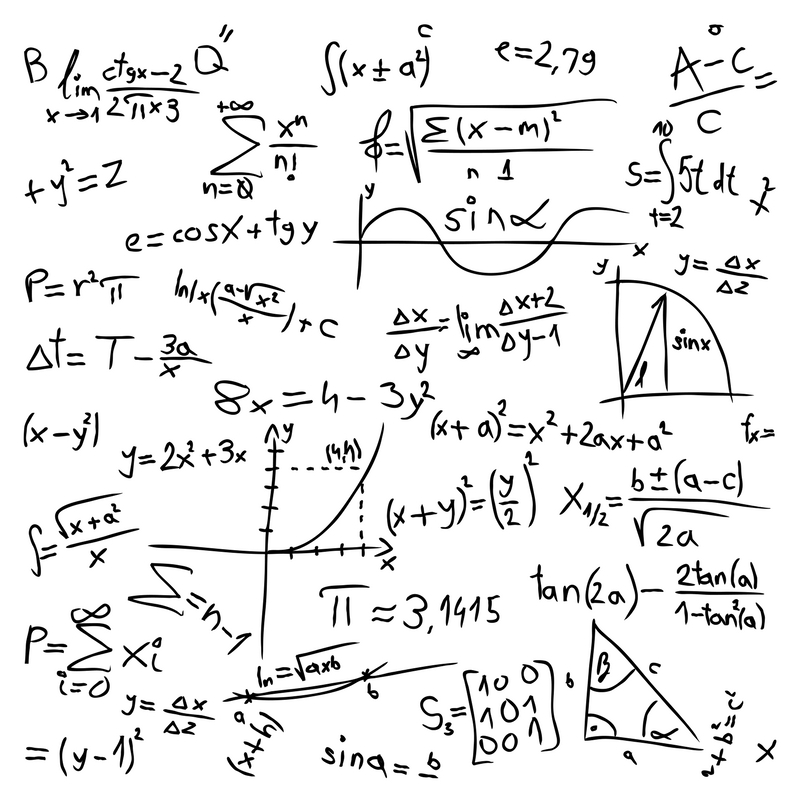
Is there more angst spilt in homeschooling over any subject more than math? Math is a subject none of us want to mess up. Once our children hit middle school, people start asking how we think we’re going to teach upper level math competently. And we wonder that ourselves, too, even if we don’t like being asked about it.
It’s possible to wing math in the early years, but because math is a consecutive skill, where one concept builds upon another, it’s best to choose a program and stick with it. Different programs use different vocabulary. Different programs teach concepts in different orders, but different logical, step-by-step orders – so skipping around between programs can lead to gaps and confusion more than in any other subject.
We’ve been using Math-U-See for more than a dozen years now, and with all my students so far. My oldest went from Math-U-See Precalculus to Precalc II at the community college in tenth grade. We use the video lessons (I’ve watched them too, so I understand how to teach the material) and the blocks – the whole package. I love it.
In the last decade of sticking with the same program and walking 5 students through the process, these are my top 5 tips for using and organizing Math-U-See. Stay tuned after the tips for my rave review of Math-U-See, too.
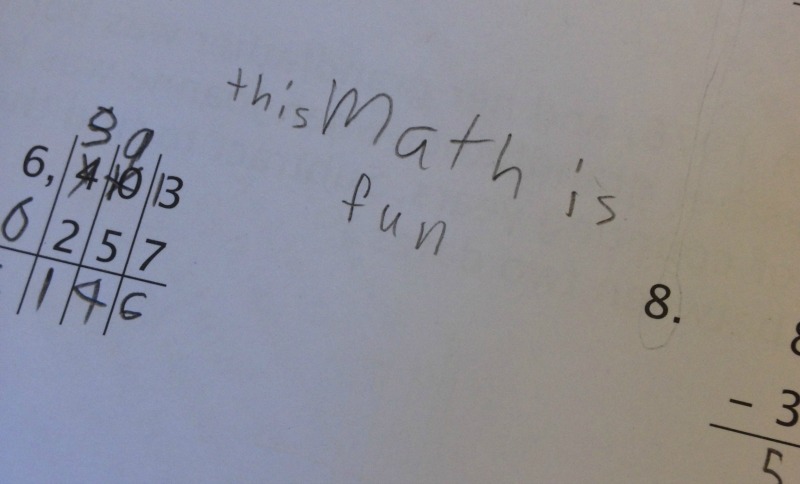
If you use Math-U-See, please share your tips and suggestions in the comments, too!
Math-U-See Tip #1: How to store the blocks
Math-U-See blocks are a core of the curriculum, and they are very cleverly designed and implemented in the program. You can buy a wooden case from them to store your blocks, but that’s rather pricey.
Instead, I use a wide, shallow 25-qt Sterilite container with a latching lid. Kids can dig around and find the block they want quickly, but we can also put them away quickly because we don’t have to sort them into correct cubbies.
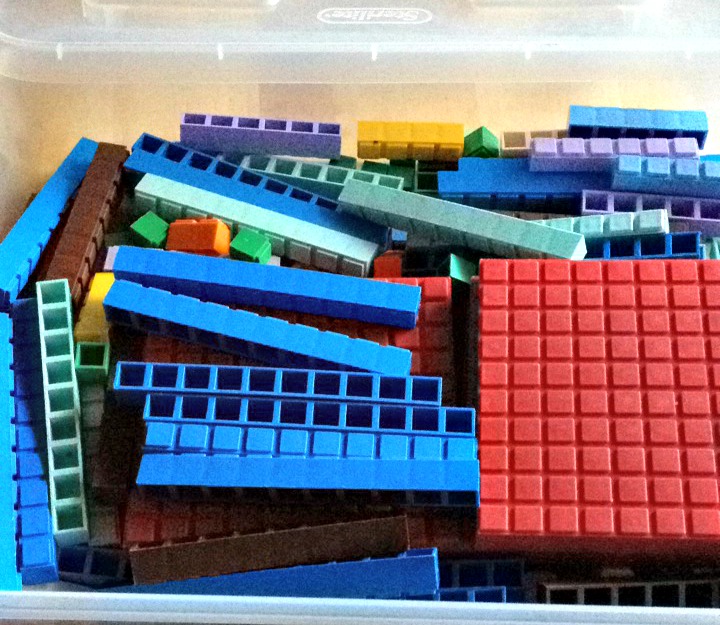
Math-U-See Tip #2: Reserved Crayons
In Primer and Alpha, kids do quite a bit of coloring with their math. As they learn the blocks in the first few lessons, they’re supposed to color the blocks the right color. With my first student, we hunted around the crayon bin every time, with my son constantly asking, “Is this an ok color? Is this one ok?”
When I ordered Primer for my third, knowing I had at least 2 more after her, I got smart and set aside hand-picked crayons. I pulled out the colors that best matched the blocks and stuck them in a small container that lives in our math book bin.
When she sat down with her lesson page, she had the little container with just 10 crayons, and it was clear which color was intended.
Math-U-See Tip #3: Pull out the pages, use clipboards, have a “turn in” container
This Math-U-See workflow is probably my best tip. Is it ok to put the best tip in the middle?
First, I tear out the math page to be completed each day from the workbook. The kids do not handle the workbooks themselves directly. If they did, the covers would be torn in no time and I’d have a headache figuring out what I’m supposed to be assigning and checking in each of the 4 books that won’t stay open to be checked.
After all, Math-U-See is a mastery-based program. My kids never do all the pages in the book and sometimes they need more pages than are included in the book (we use the tests as extra work pages and also print extra practice off their website). When I tear out their workpages and stick them on their color-coded clipboards, it doesn’t matter whether I pulled the page from the workbook, the test book, or off the printer – they know and I know their math for the day is on their clipboard.
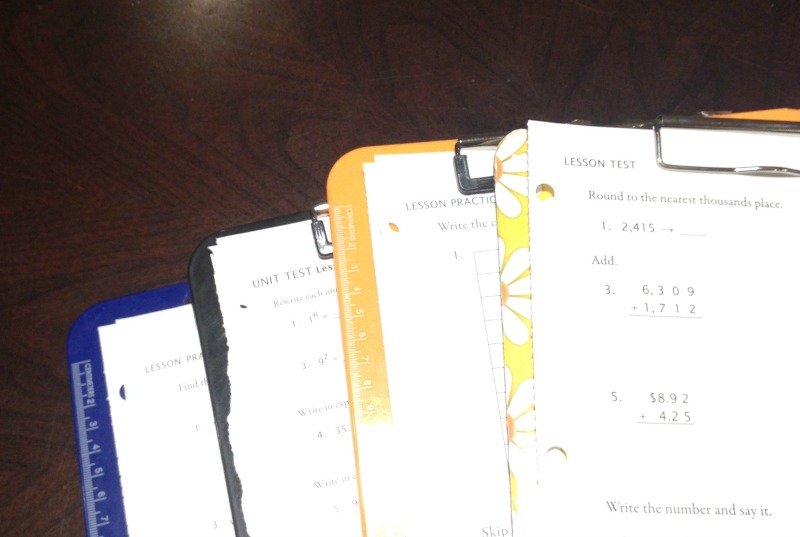
Plus, we make them correct their work until they get 100% – mastery approach, right? So if a page wasn’t 100%, it goes back to the clipboard. Whatever is on the clipboard is the work to be done.
And where does it go when it’s done? At one point they were supposed to put it onto my clipboard when they were finished so I could check. However, my clipboard could be anywhere and it always had other things I wanted to see on top, too. They couldn’t always find it and I didn’t really want those extra pages cluttering it up.
So, I bought a mail sorter and it lives on the counter. When they finish their math, it goes into the mail sorter to be checked. If it’s all correct, the page goes into the trash or fire-starter bin. If it needs another attempt, it goes back on the clipboard.
Now that my husband checks the math, this process also makes it obvious to him when there’s math to correct. If it’s in the mail sorter, he knows it’s his to-do.
Figuring out a workflow process so everyone knows exactly what needs to be done with the least amount of rifling and questions is the goal.
Math-U-See Tip #4: Lined paper sideways for figuring
I got this tip from Mr. Demme himself.
Place value in Math-U-See is important. Keeping numbers straight and in their right place is critical, no matter which math program you use.
My older students use graph paper to show their work, but that seems a bit excessive (and also not large enough squares) for the elementary students. Once they get into carrying or borrowing, though, it’s super handy and leads to fewer place-value flubs if you simply turn a lined piece of notebook paper on the side to help you keep the numbers in their right place.
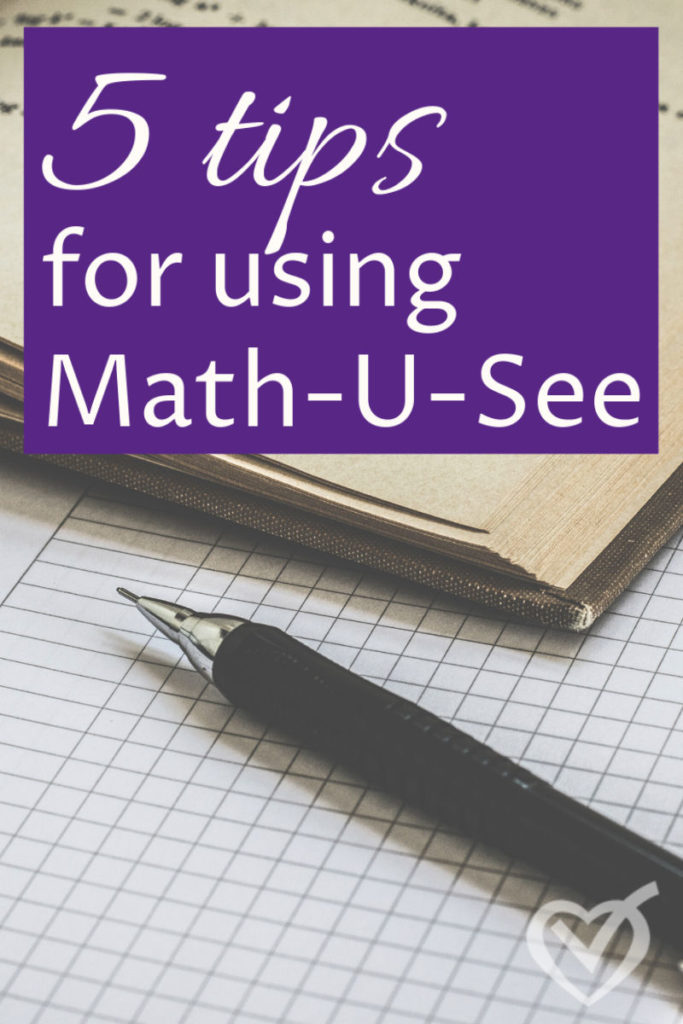
Math-U-See Tip #5: Add in regular drill
I appreciate and value the mastery approach of Math-U-See, and they emphasize knowing the facts perfectly before moving on. However, if they don’t use them, they lose them, and knowing the facts isn’t the same as being able to do them quickly.
So we add drill practice to our daily math routine, at least for the elementary students. I use both xtramath.org (love it!) and Calculadder. We’ve also added times table chanting to Morning Time before because those facts needed review.
No matter what program you’re using, we as the homeschool mom need to be alert and wise in applying it and adding in supplements or taking a break or pausing to review based on what each child needs to make progress.

HOMESCHOOL AUDIT
Make next year better based on how this year went.
Download the free homeschool audit and use this year’s experience to make next year better.
Want more Math-U-See Tips?
Listen to this podcast episode where Mystie and Virginia Lee, both homeschool moms of 5, both users of Math-U-See, chat about how they organize their math materials and methods to keep everyone moving forward.
Topics covered:
- Why the mastery approach has worked so well for our kids and our peace of mind as non-mathy moms.
- What we do when our child seems stuck in a lesson.
- How we use the video lessons and math blocks.
- What we think about the non-standard Math-U-See scope and sequence.
- The important role of checking and correcting math pages for mastery.
- How Dads can help with making math happen without resistance.
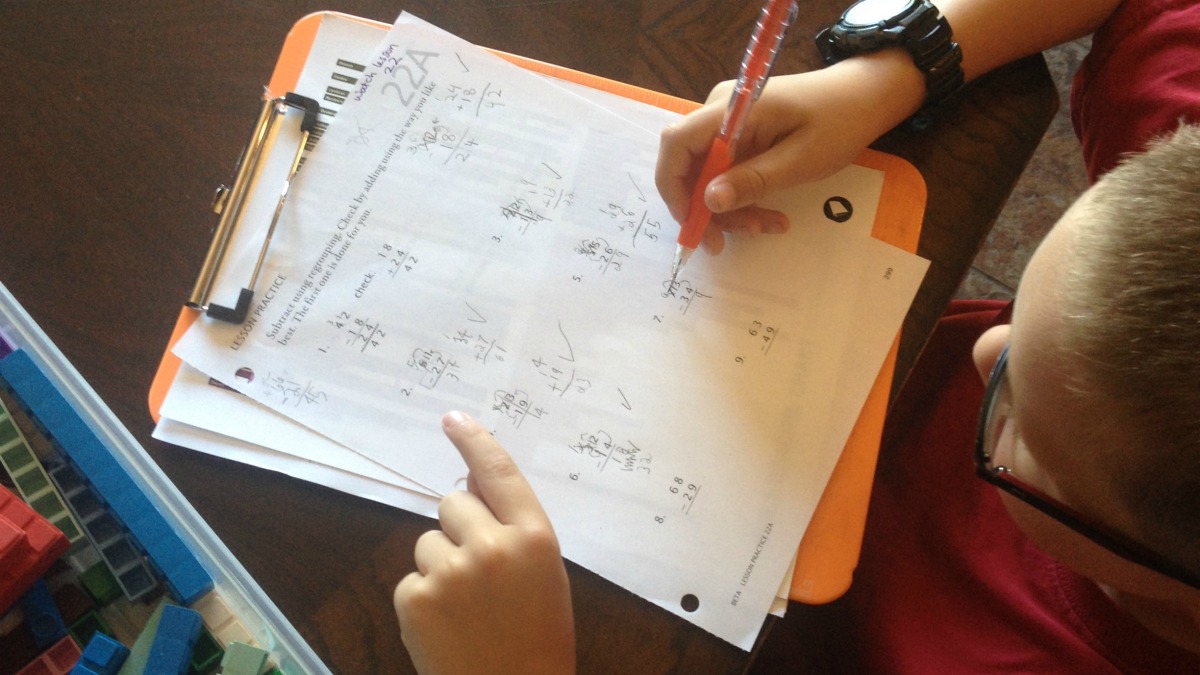
Why I Love Math-U-See: A Review
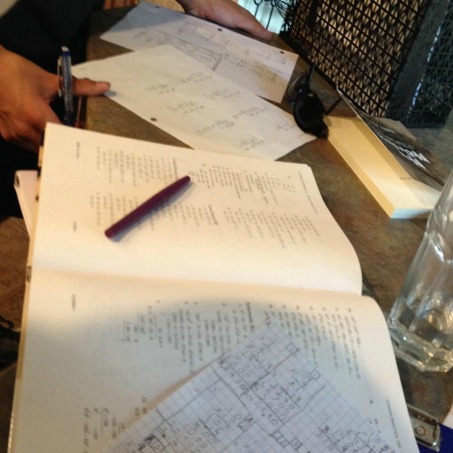
I am not a math person. Math has been the subject that daunts me most when I think about the big picture of homeschooling. Or, at least, it did. Now that I’m 9 years into this gig (if you start counting with Kindergarten) and I have an 8th grader who is about to finish Algebra, I’m neither daunted nor worried.
I am so glad that when my oldest was 4 or 5, I had two real-life friends rave about Math-U-See. Not only did they rave, but one of them sat me down and had me watch the “adding 9s” lesson. I was sold then and there.
Perhaps part of the reason I like Math-U-See is that it is pretty much the opposite of Saxon, and I hated Saxon as a homeschooled student. MUS has short lessons; Saxon lessons are exhaustingly tedious. MUS focuses on mastery; Saxon is a spiral approach.
MUS uses manipulatives to teach, even in 5th & 6th & 7th grade, making math very concrete; Saxon is abstract, and as a student I was quickly lost in the words and what they meant.
MUS has no instruction in the student text, instead parent & student are supposed to view the DVD instruction together and the teacher’s manual gives suggestions for teaching the concept to the student (without a script); Saxon presents each concept (abstractly) in pages of dry text in the student book, which if done as independent work, can quickly leave the student lost (and it might take 10 or more lessons before she realizes she’s lost, and then it might feel hopeless and like something it’s better not to draw attention to – and the “she” is actually “me”).
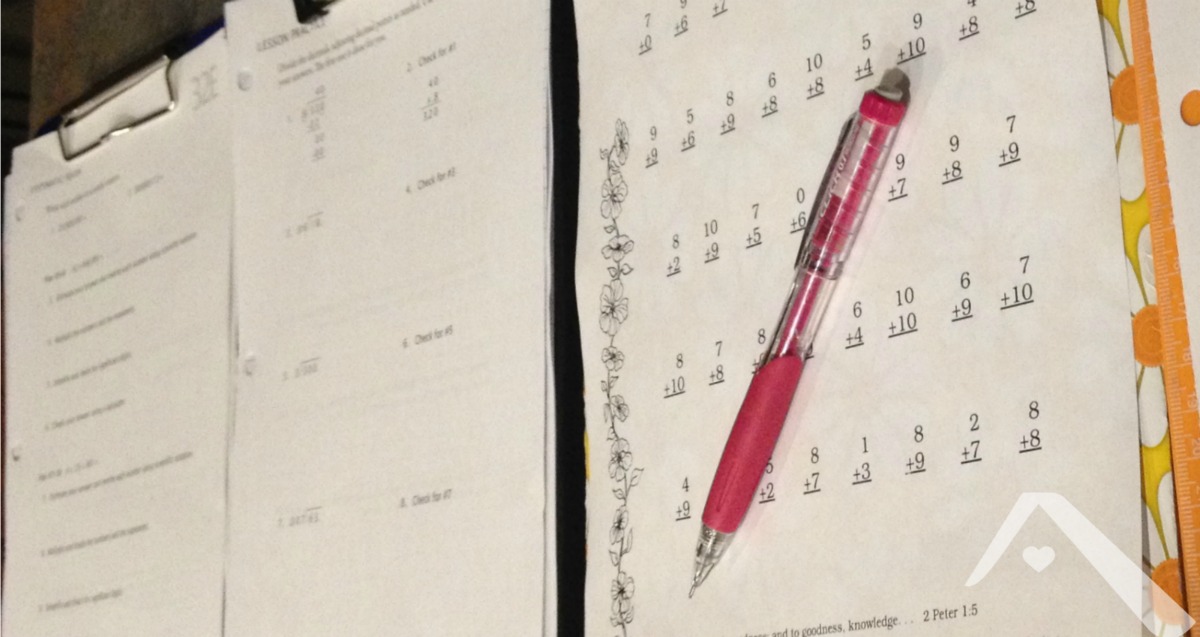
So, here’s my song of praise to Math-U-See:
I love Math-U-See’s manipulatives.
Math-U-See is based on the foundational principle that math should be concrete before it is abstracted. Abstract comes after understanding, but understanding follows concrete demonstration and concrete work. The name itself refers to the fact that it is all about literally seeing – through manipulatives, even into algebra – how math works.
There is no memorizing of formulas or answers before it is demonstrated that the student concretely understands the why and how behind the functions, and can do them (and teach them) with the manipulatives.
The manipulatives themselves are clever. There is a bar-block, almost like a large Lego, for each unit and also for tens and hundreds. Unlike cuisinaire rods, each block has squares equal to its value, aligned in such a way that they can be stacked.
With these blocks, the DVD instructor (and author of the curriculum, a homeschool dad who didn’t like any of the math options available) demonstrates that “equals” means “same as.” He sets up a four-block and above it two two-blocks and shows they are the same length, they are equal, and equal is written as two same-length lines.
When we get to subtraction, he puts up an eight block, then turns a four block upside down on top of the eight (the back side has hollow squares, and now the demonstration looks like a subtraction sign). How many squares are left after 4 are gone?
With these blocks, learning x + 3 = 5 is also simple, and taught very early on. Set it up with the blocks, the five on the bottom, the three on the top. What do you need to make them equal, to make it look like an equal sign?
Making shapes with the blocks also makes it clear what “area” and “perimeter” mean and why the math gets you the right answer.
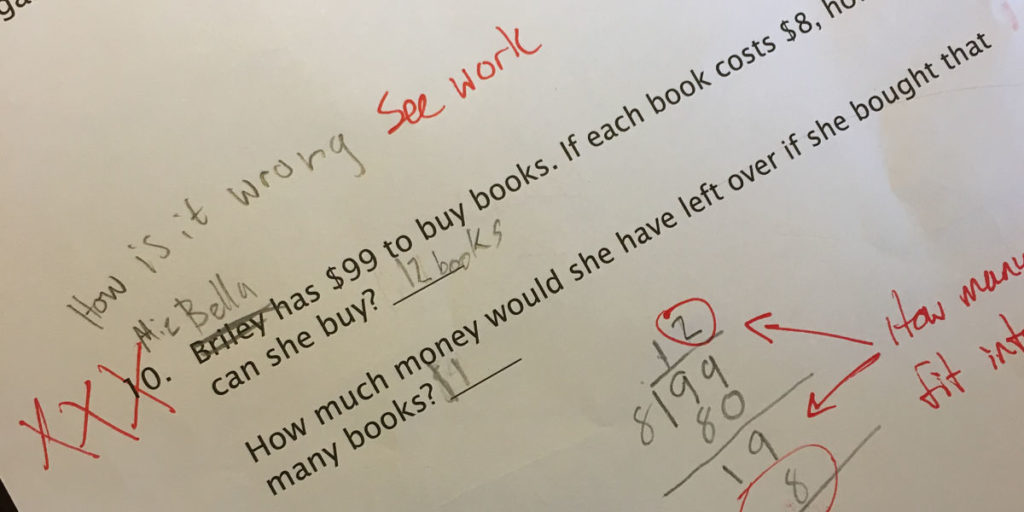
Multiplication is taught with skip counting and pattern recognition as well as with the blocks. Multiplication is finding area. 3 x 3 means “3 by 3” or three up and three across, and when you construct that, you can see it is the same as 3 3s and totals 9.
Even fractions get their own special manipulatives that make it clear why a fraction of a fraction (that is, fractions multiplied) is smaller rather than larger, why you have to have the same denominator to add, and how 1 can be represented by fractions.
Fractions were still painful for my students so far, but I felt better equipped as a teacher to go back to the basics, to explain with clear terms, and to stick with it until they mastered it (rather than moving on as soon as they had a “C”).
There are even Algebra manipulatives! However, my first and so-far only Algebra student hasn’t used them. He watches the video teacher’s demonstration and jumps right into abstract – he’s ready for that kind of thinking. He understands the concepts and gets most problems correct, so I don’t force him to use the manipulative himself.

HOMESCHOOL AUDIT
Make next year better based on how this year went.
Download the free homeschool audit and use this year’s experience to make next year better.
I love Math-U-See’s emphasis on place value.
Math-U-See begins with the concept of place value and returns to place value to teach every new function. Without place value, you can’t understand why numbers do what they do when you start combining them, so it is important.
Math-U-See has some handy sayings for learning place value – like “Every number has a place” and “place means value.” The numeral 9, for example, means 9 units if it’s in the unit place, but it means 9 tens if it’s in the tens place. It has been quite helpful to have this vocabulary to show my beginning-regroupers that 12 + 8 does not equal 2. Without the zero, that means 2 units, not two tens – you need the zero to put the 2 in the ten place.
Place value is also helpful when they want to work equations from left to right, like reading and writing. No, with math you have to start at the unit place and move up the “street” from there.
Place value brings greater clarity to long division, too. And when you hand your student graph paper on which to do his figuring (highly recommended), you can always remind him, “Keep each number in its right place!” and he might sigh and slump, but he knows what you’re talking about.
I love Math-U-See’s mastery approach.
Personally, I was burned as a math student by just cruising along at a lesson-a-day pace, self-correcting and able to call a grade “good enough.” For a time, I was able to just get the right answer, often enough, to keep going until one day I was halfway through the book and totally stuck.
With Math-U-See, there are concrete ways to demonstrate understanding. This curriculum is designed to help students see how numbers work, not just drill in steps to get the right answer. Saxon was written to help kids test well. Math-U-See was written to help kids understand why formulas work.
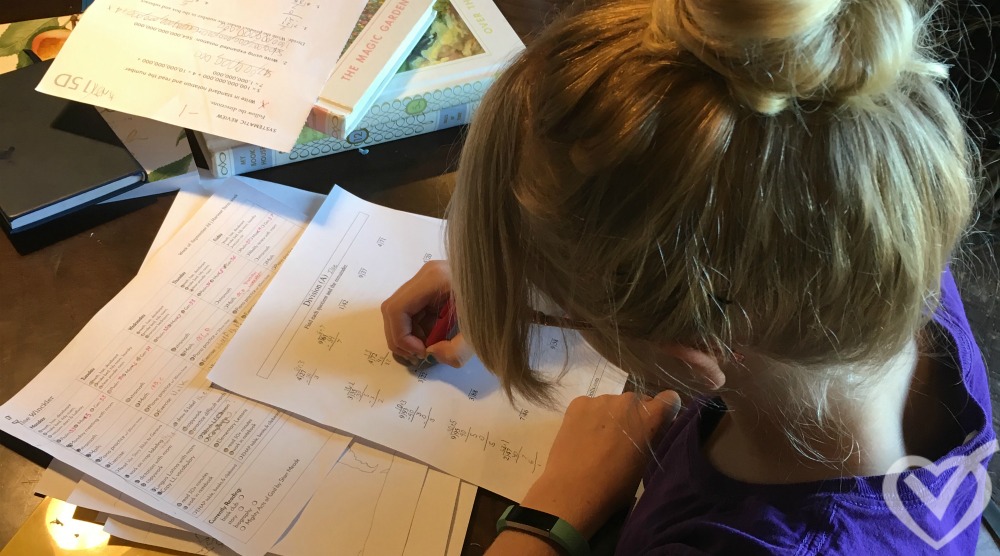
The mastery approach is epitomized in the fact that MUS books do not have grade levels. You start your child when he’s ready and you move at his pace. There is no such thing as “behind” or “ahead,” only where your student is. Math-U-See wants your kids to have all the facts drilled, understood, and quickly correct before moving into more abstract math. That might take a year, it might take longer, but don’t move on until they have it.
In our home, sometimes it appears there is mastery (evidenced by 100% on math pages on the first attempt), but later it becomes evident they’ve forgotten. So we go back and review until there’s mastery – again. Better to keep those foundations shored up than to build on a shaky foundation. In the end, the building will be higher and stronger.
Math-U-See is set up at approximately a lesson-a-week format, although they never explain it in those terms, because the point is mastery, not a book-a-year pace. This is how it works for us:
- Day 1: Watch the lesson, work the first few problems with mom (for elementary students), complete page xA. If they get it and want to move on, they have to also complete a Systematic Review page and get 100% on it. If they don’t get 100% on the first try, they have to correct the page until it is 100% – leaving errors unsolved is not acceptable.
- Day 2: If it seems like they need more practice with the concept, I give them the B page. If it seems like they understand it, I give them a systematic review page. Either way, if they get 100% on the first attempt, they pass that lesson. If they do not get 100% on the first attempt, they rework their errors until they do have 100%.
- Day 3: Same as Day 2.
- Day 4: Same as Day 2.
And so on…because they’re reworking every error, they’re incentivized to work correctly the first time – sloppy work that leads to errors will always have to be fixed, so it never saves time. Because all errors have to be worked until they are correct, we are always aware and working on the concepts they are having trouble with.
I often watch them rework errors, and in that way have seen when more review in multiple-digit multiplication or fractions or some other foundational concept is the tripping point.
When I see a specific skill needs to be reviewed, we take a break from the current lesson and go back to practicing the foundational skill that is causing the errors – yes, sometimes that’s even meant practicing number formation because 4s look like 9s or 6s look like 0s.
This approach does require teacher awareness and involvement. Welcome to homeschooling – we signed up for this gig.
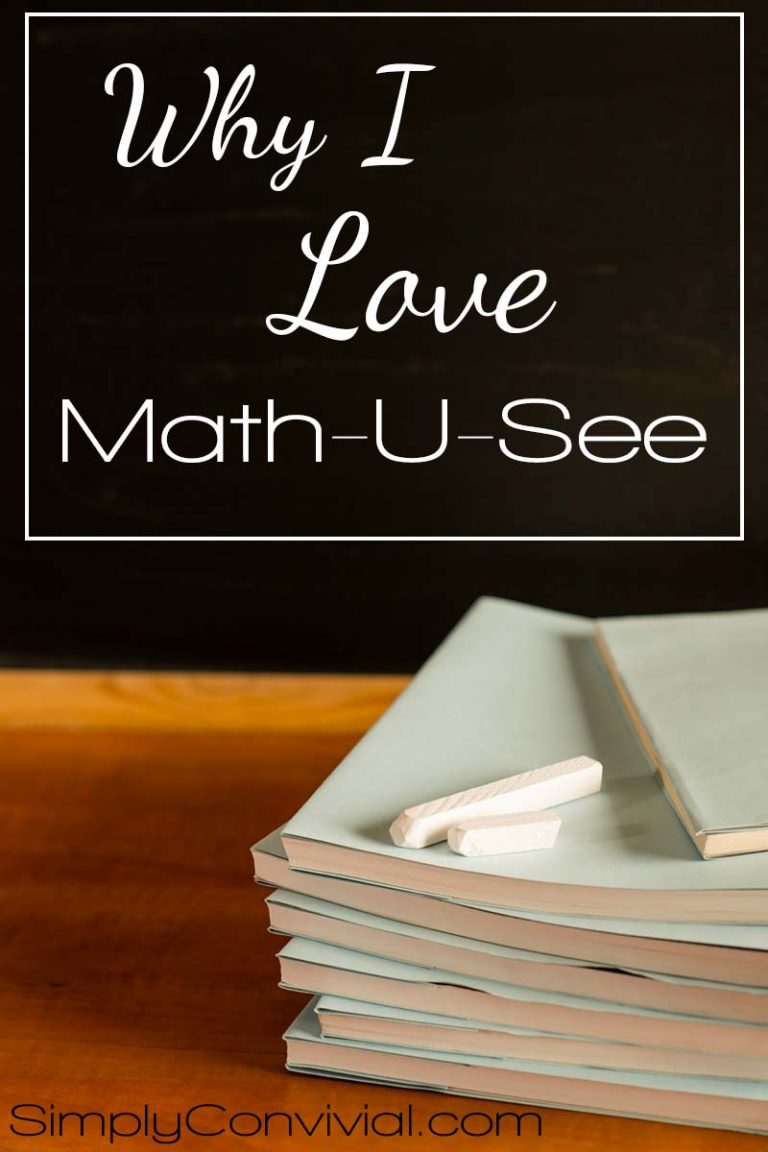
I love Math-U-See’s DVD instruction.
Now, although I have to be aware of what’s going on and how my kids are doing, I don’t have to pull up the inner resources to teach concepts directly to each one of them.
Instead, they learn the concept by watching the author of the program teach it – engagingly, with humor, with multiple concrete examples and explanations. I couldn’t pull that off myself, but watching him do so helps give me a starting point and a vocabulary when I do sit down with a child and his math page.
Plus, I can have them review by rewatching lessons – and unlike myself, recorded Mr. Demme is still just as cheerful and still just as ready to crack a joke the third time as the first.
That’s a plus.
I love using the same math curriculum for all my children.
Currently, I have 1 student in Algebra, 1 in Zeta, 1 who will start Gamma as soon as she passes xtramath addition, 1 who just started Beta, and 1 who is learning to write her numbers and count.
I know some choose different math curriculums for different kids, but unless you have a really compelling reason and pressing situation, I recommend choosing the curriculum that resonates with you as the mother-teacher.
Learn one system, know the ropes, be able to adapt and teach math with the curriculum (even if there’s a DVD teacher provided), and you’ll experience better success than if you expect the curriculum to do everything for you and your student. What can you teach? What math curriculum can you be grateful for every time you pull it out? Stick with that one and you’ll have a greater likelihood of consistency and success.
Switching math curriculums comes with a high cost, as different programs teach with different vocabulary, in different orders, and in different ways. For awhile, you’re not necessarily learning math, just learning a new system of learning math. Better to find a program that fits you, then teach it to each of your children.
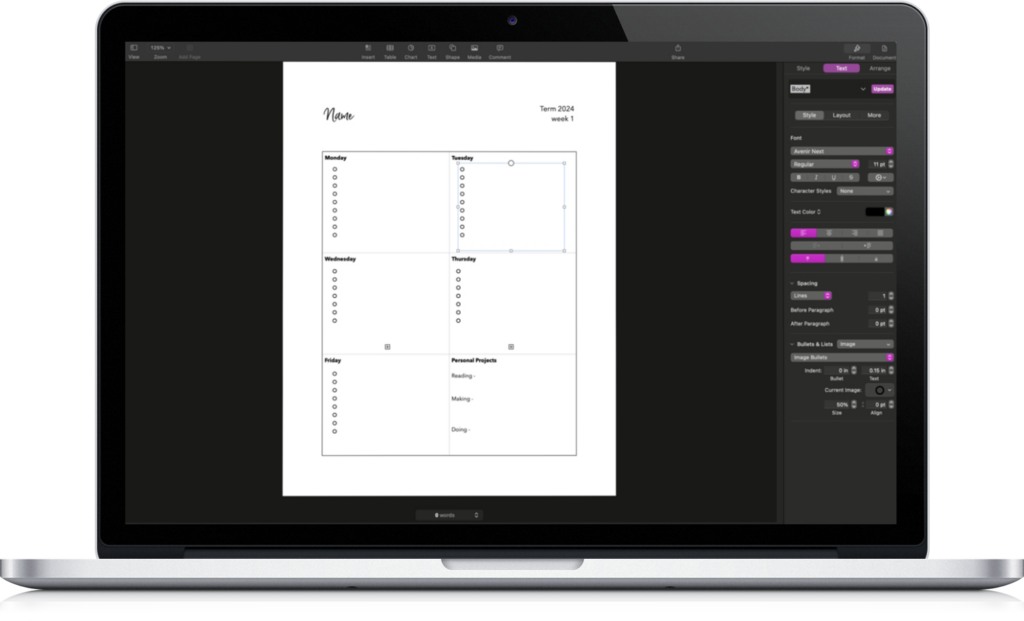
Get 5 of my favorite homeschool checklist templates!
Jumpstart your homeschool checklist practice by starting with one of my proven formats. Open, edit, and make them your own! Plus, get tips and followup, too –

Membership created from mystie’s import.
Can I ask a clarifying question? I’m late to this post but I needed to read this today! Is your method to not move on to next lesson until a systematic review page is done 100% the first time? And each day a systematic review is done until that happens?
Also did you have any kids that often take a long time to complete their worksheets? What is an appropriate amount of time and how long do you let that go? Or do you cut times shorter or timers or anything? I don’t wanna make it stressful but sometimes I just think things get belabored—
Also, do you use the tests? Is it important to do the testing? I have been thus far but curious how you use it…
Sorry for so many questions! :)
We are using Math-U-See but are just finishing up Alpha. How important is it that they know the colors of the blocks? I haven’t worried too much about making my daughter color the blocks the right color because she hates it, and I’ve figured that if she understands the concept that it doesn’t matter that much if she knows the correct color. But…if later on that’s important then I will change that! Thanks!
No, that’s not important except that it allows them to quickly grab the right block without counting the squares. I’d also be watchful for not letting the habit of doing her own thing instead of following the instructions begin. Color isn’t a big deal, but following instructions as written and wrong v. right answers are foundational in math.
It’s not necessarily a big deal, but just keep your eyes open that you don’t let her call the shots and not do something if she hates it. It’s less about the color of the block and more about paying attention to the habit of attitude and work being practiced.
Thanks for that friendly kick-in-the-pants reminder to make her follow instructions, even if she’s not a fan of them. =) I guess it’s not so much that she hates it (and that therefore I let her off the hook), it’s more like if she hates it AND I think that it’s just busy work then I’m likely to let her skip it if she understands the concept. If she knows that 4+5=9 and can answer that and write the correct numbers by the blocks then I don’t really care if she knows the color of them UNLESS it’ll be important later on, which with this I haven’t seen how it could be important. Does that make sense? I always make her correct mistakes so she’s not getting away with wrong answers.
Yeah, I am also allergic to busy work and totally get it. I think that’s fine, especially if it comes across and you making the decision and not her. :)
Mystie,
My kids have struggled in math (except the youngest! ?). I used to think they just were not good in math, but I realize that they have not gotten a good foundation. We have tried different math curriculums. I was just about to start Saxon, but my son has transferring problems and my 17 year old has not done well with Teaching Textbooks. TT seems to leave out important ideas or their own math vocabulary which doesn’t help,understanding! We just seem to be getting farther behind. Do you think Math U See could help with remediate my struggling students? ?
Hm, that’s a tough one. I think if they’re under 10, probably. With older students, I think MUS’s different system starts earlier than you’d want to go back and it’d be too different to be helpful. For teens, I’d try xtramath drill and Khan Academy – or try to find tutoring help with a standard text like Saxon. As a struggling homeschool math student myself left alone with Saxon, I know that doesn’t work. :)
Hi! We did the whole switching curriculum, moving constantly, piles of tough pregnancy thing. My eldest two are behind (late teens).
Khan is common core aligned. I was crazy disapointed to find that out. Any concerns about the methodology Sal uses there? Or do you still think it’s a good remedial for older way behind but smart students?
We only used Khan videos when my kids needed a different explanation of a concept because they weren’t getting it, but we stuck with the MUS sequence. We never systematically worked through Khan’s lineup, just watched videos here and there and did some of the work to get extra practice.
For catch up for older students, I have used and recommend the Learn Math Fast series.
Long (looooooonnnnng) time user of MUS here too – I love your tips and use most of them myself!
Yes we dropped using that divided wooden box years ago when I realized my kids were dreading using the blocks every day precisely because they hated the meticulous way the blocks had to be put away. Now ours are in a big tub too, just randomly dumped, and even my toddler loves to “do math” (aka, play with the blocks).
This is so simple and so utterly brilliant and I am downright embarrassed I never thought of it. We are definitely doing this TODAY.
Are your clipboards for your kids filled daily or weekly?
This helps my kids so much, and even my older kids will occasionally sketch themselves some light lines to keep their columns straight when they run across a problem like that.
This is an absolute must!! I’ve used Calculadder but hate hate hate the weird checking method. (Is it just me?) We are currently using the drill page offered on the MUS website, which my kids think is fun, so it works. Xtra math is great too!
We also use MUS and have for the past two years (kiddos are now in 1st and 3rd), and I’ve been contemplating trying a different program next year…but now that I’ve read your post, I’m second guessing again! ? I feel like there are missing concepts that need to be filled in (time, money, fractions, etc.) but I LOVE the mastery approach. So I’ve been supplementing, like you suggested. So thanks for giving me some food for thought! I need to remember that the curriculum serves me and the kids, not the other way around. Ah, the struggles of a former classroom teacher! ?
Hello Kelly,
I have used Math-U-See for many years, and if you like the concepts of Math-U-See, I would encourage you to stick with it. Time, money and fractions will be taught in future Math-U-See books. And you can use “real life” teaching for giving your children any aspects which they need now e.g. measuring during baking is an excellent way to teach fractions.
Blessings,
Angela
When you say you put the worksheet back on the clipboard if it isn’t 100% do the students just fix the missed problems or do the whole thing again?
Thanks,
Rachelle
They simply correct any and all errors. :)
it is now 2020, do you still love Math U See? Reading all kinds of reviews on this curriculum….wanting to try, but did you stick with it?
We still love and use Math-U-See! Our fifth child is in Beta and our oldest finished Pre-Calculus and entered the community college qualifying into Pre-Calculus II at 16.
Can you reuse the teachers books? I see so many on selling walls.
Is it necessary to complete H pages in upper levels?
We don’t. :)
Hello! Just wanted to say thank you for this fantastic and thorough post! It had just what I needed and wanted to know right now, and I loved how you compared to Saxon and gave a lot of real life examples of how you’ve used and enjoyed it. My first grader is almost done with Alpha and looks forward to math every day. I LOVE the way Mr Demme explains concepts and makes everything make sense for both of us. I was second guessing the mastery approach and have many friends using Saxon, but the more I research the more I conclude I shouldn’t mess with something that is working so well for us and that my child is excelling with. Thank you also for the supplemental tips. If you are still responding to these comments I’d love to understand a little more about how you supplement to teach some of the concepts they would learn in say Saxon, and how that has played out when your kids have been tested?
can you clarify what systematic review is in the following quote:
“Day 1: Watch the lesson, work the first few problems with mom (for elementary students), complete
page xA. If they get it and want to move on, they have to also complete a Systematic Review page and
get 100% on it. I”
it is just the worksheets.?
Can you also tell me how you incorporate the xtramath you’ve mention, and finally,
can you talk about how your kids did with the standardized tests. I know I will feel anxious any time they are “behind” even tho fundamentally I know it’s fine if they are.
Systematic Review is what Math-U-See calls the 3 pages after the “Lesson Practice” pages that contain cumulative review problems.